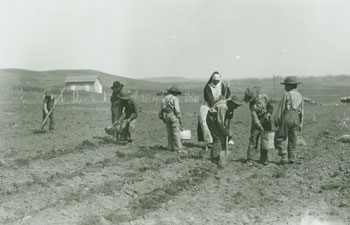
Sister Berthold and Indian boys gardening. SHSND# 1952-1805This evening I picked chokecherries in the Big Pasture, starting home just at sunset. Ducks were feeding quietly along the river. Behind me the hills were turning lavender. In front of me the fields were a golden mist. My country. (Low, p. 69)
For these two women, gardening was a part of a woman’s work in feeding her family and safeguarding them from hunger during the Great Depression. But it was never just work. They enjoyed being outdoors, working with plants, seeing the size of the harvest. It was a matter of pride that they squeezed some crops out of the toughest years on the Great Plains. Gardening was also social, bringing them together with mothers, brothers, sisters, and sometimes neighbors which made the work easier and gave them precious social time which otherwise was hard to find on a Depression-era farm.
A diarist, Nancy Hendrickson, was also gardening during the Great Depression. She had a ranch on the Heart River and a small family of adults (husband and brothers) to care for as well. While her diary offers less insight into her gardening practices in the 1930s than other events, she does mention that field crops burned up. She wrote of canning wild fruits such as bullberries (buffaloberries), Juneberries, and plums (209 quarts in 1936), but during the 1930s mentioned canning vegetables only once on September 16, 1935 when she canned tomatoes and picked squash and “vine truck.” The other vegetables she mentions are root crops such as carrots and rutabagas. In 1936, a particularly bad year, Hendrickson wrote in her diary that she bought tomatoes and melons from a Mandan store. (24 September 1936)




